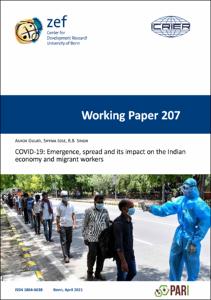Gulati, Ashok; Jose, Shyma; Singh, B.B.: COVID-19: Emergence, spread and its impact on the Indian economy and migrant workers. Bonn: Center for Development Research (ZEF), 2021. In: ZEF Working Paper, 207.
Online-Ausgabe in bonndoc: https://hdl.handle.net/20.500.11811/9758
Online-Ausgabe in bonndoc: https://hdl.handle.net/20.500.11811/9758
@techreport{handle:20.500.11811/9758,
author = {{Ashok Gulati} and {Shyma Jose} and {B.B. Singh}},
title = {COVID-19: Emergence, spread and its impact on the Indian economy and migrant workers},
publisher = {Center for Development Research (ZEF)},
year = 2021,
month = apr,
series = {ZEF Working Paper},
volume = 207,
note = {This study examines the impact of the Covid-19 pandemic and the related nationwide lockdown on the Indian economy, particularly on food systems. It also takes up an important issue of millions of migrant workers in India who seem to have suffered the most during this period. The loss of their livelihood, incomes, and food insecurity are captured through a survey of 2917 migrant workers in six different states of India. At the end, the study gives recommendations on how to broaden the support for migrant workers nationwide. Due to the pandemic-induced lockdown, the Indian economy contracted 24 percent in the first quarter of the financial year (FY) 2020-21 (April-June). The worst affected sectors were construction, trade and hotel and other services, and manufacturing. Consequently, the unemployment rate surged to 23.5 percent in April 2020. Given the easing of lockdown and measures taken by the government in the wake of the first wave of the pandemic, the economic growth revived to -7.5 percent in the second quarter of FY 2020-21. The food processing industry particularly manufacture of grain milling products, dairy products and animal and vegetable oil, were resilient during the lockdown. However, the pandemic adversely impacted the processing and preservation of meat, fruits and vegetables. Notably, the agricultural sector is the only sector that recorded a positive growth rate of 3.4 percent during the first two quarters of FY 2020-21. Nevertheless, the disruption of the agri-food supply chain, particularly during the initial period of the lockdown, pushed food inflation from 8.8 percent in March 2020 to 11.7 percent in April 2020, but it came down to 3.4 percent by the end of the third quarter (December) of FY 2020-21. The unprecedented migrant crisis was one of the major catastrophes that emerged during the pandemic.},
url = {https://hdl.handle.net/20.500.11811/9758}
}
author = {{Ashok Gulati} and {Shyma Jose} and {B.B. Singh}},
title = {COVID-19: Emergence, spread and its impact on the Indian economy and migrant workers},
publisher = {Center for Development Research (ZEF)},
year = 2021,
month = apr,
series = {ZEF Working Paper},
volume = 207,
note = {This study examines the impact of the Covid-19 pandemic and the related nationwide lockdown on the Indian economy, particularly on food systems. It also takes up an important issue of millions of migrant workers in India who seem to have suffered the most during this period. The loss of their livelihood, incomes, and food insecurity are captured through a survey of 2917 migrant workers in six different states of India. At the end, the study gives recommendations on how to broaden the support for migrant workers nationwide. Due to the pandemic-induced lockdown, the Indian economy contracted 24 percent in the first quarter of the financial year (FY) 2020-21 (April-June). The worst affected sectors were construction, trade and hotel and other services, and manufacturing. Consequently, the unemployment rate surged to 23.5 percent in April 2020. Given the easing of lockdown and measures taken by the government in the wake of the first wave of the pandemic, the economic growth revived to -7.5 percent in the second quarter of FY 2020-21. The food processing industry particularly manufacture of grain milling products, dairy products and animal and vegetable oil, were resilient during the lockdown. However, the pandemic adversely impacted the processing and preservation of meat, fruits and vegetables. Notably, the agricultural sector is the only sector that recorded a positive growth rate of 3.4 percent during the first two quarters of FY 2020-21. Nevertheless, the disruption of the agri-food supply chain, particularly during the initial period of the lockdown, pushed food inflation from 8.8 percent in March 2020 to 11.7 percent in April 2020, but it came down to 3.4 percent by the end of the third quarter (December) of FY 2020-21. The unprecedented migrant crisis was one of the major catastrophes that emerged during the pandemic.},
url = {https://hdl.handle.net/20.500.11811/9758}
}






